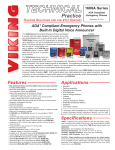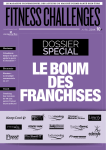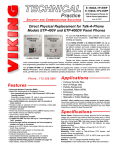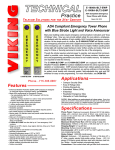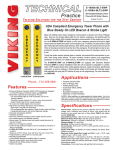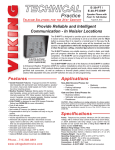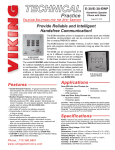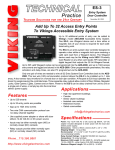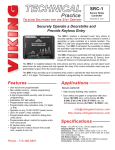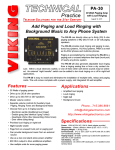Download Viking E-1600-03A Specifications
Transcript
TECHNICAL Practice 1600A Series Practice TELECOM SOLUTIONS FOR THE ADA Compliant Emergency Phones 2 1 S T C E N T U RY July 3, 2001 ADA* Compliant Emergency Phone with Built-In Digital Voice Announcer K-1600-EHFA E-1600-45A E-1600A E-1600-02A E-1600-03A The 1600A series emergency phones are designed to provide quick and reliable handsfree communication over the public switched telephone network. The 1600A series meets ADA* requirements for elevator telephones, and can be programmed from any Touch Tone phone. The 1600A series phones can automatically send the digital announcement to identify the location of the emergency call, then automatically light the call connected LED. The 1600A series can also be used with Central Station Monitoring equipment. All parameters, phone numbers and location numbers are stored in non-volatile E2 memory. All units are phone line powered, requiring no batteries or external power sources. ! Attention Panasonic DBS Users: The 576 DBS systems do not conform to analog telecom standards and are incompatible with the 1600A Series Emergency Phones and E-30 Handsfree Phones unless modified. To use these products with a Panasonic 576 DBS System, please retrieve Fax Back Document 857. Features Applications • Non-volatile digital voice announcer with 10 seconds of voice memory • Advanced call progress detection • Can automatically light the “Call Connected” LED for the hearing impaired • Handsfree operation • Phone line powered • Non-volatile E2 memory (no batteries required) • Touch Tone or pulse dialing • Dials up to 5 different numbers on busy or no answer • Transmits a unique location I.D. code • Grade 2 Braille label for the visually impaired • Hangs up on CPC, silence, busy signal, dial tone, time out or Touch Tone command • Programmable to auto-answer on incoming calls • Remotely programmable • Extended temperature range (-15°F to 130°F) • 5 different chassis or board only available • Central Station Monitoring capability • Separate central station voice speed dial number • Optional PB-100 Polling System available • Elevators • Parking ramps • ATM machines • Area of refuge locations • Lobbies • Entryways • Campus emergency stations • Roadside emergency stations • Stadiums • Convention centers * Americans with Disabilities Act of 1992 contains federal regulations regarding elevator telephones (Public Law 101-336). Phone...715.386.8861 [email protected] h t t p : / / w w w. v i k i n g e l e c t r o n i c s . c o m Installation and Specifications Viking offers five different chassis for the 1600A series emergency phones. In addition, the circuitry, button, speaker, etc. are available for custom applications. The following sections show mounting dimensions and chassis specifications. All PCBs are conformal coated for added weather resistance. E-1600A and E-1600-45A Power: Phone line powered (24VDC talk battery w/20mA loop current minimum) Dimensions: 133mm x 102mm x 51mm (5.25” x 4.00” x 2”) Shipping Weight: 1.13 kg (2.5 lbs.) Environmental: -26°C to 54°C (-15°F to 130°F) with 5% to 95% non-condensing humidity Material: .062” (16 gauge) steel, E-1600A - Red powder paint, E-1600-45A - High visibility yellow powder paint Connections: RJ11 Mounting: Surface mount to walls, posts, single gang boxes and 4” x 4” electrical junction boxes or recess mount in elevator phone boxes 4.00 EMERGENCY PHONE E-1600-45A only 5.25 MODEL E-1600 3.40 2.00 CALL CONNECTED Push To Call E M E R G E N C Y 0.703 diameter 4.96 3.30 3.40 1.70 (2) .20 x .40 mounting slots 1.70 .2 x .35 wire exit notch Front View (4) .20 diameter mounting holes 3.82 Back View Side View E-1600-02A (6) 0.188 diameter countersunk holes 0.25 0.25 3.100 10.50 10.00 3.800 Suggested Hardware: (6) #8 x 3/4 flat head phillips sheet metal type A screws (not included) 4.80 6.250 13.00 Power: Phone line powered (24VDC talk battery w/20mA loop current minimum) Dimensions: 330mm x 267mm x 51mm (13” x 10.5” x 2”) Shipping Weight: 3.18 kg (7 lbs.) Environmental: -26°C to 54°C (-15°F to 130°F) with 5% to 95% noncondensing humidity Connections: RJ11 Material: .125” (11 gauge) brushed stainless steel Mounting: Flush mounted in elevator cabs, ATM machines, stairwells, hallways, etc. EMERGENCY PHONE 12.500 4.70 MODEL E-1600-02 CALL CONNECTED Push To Call Minimum Cutout Front View 2.00 Side View E-1600-03A Power: Phone line powered (24VDC talk battery w/20mA loop current minimum) Dimensions: 183mm x 149mm x 39mm (7.22” x 5.86” x 1.55”) Shipping Weight: 1.36 kg (3 lbs.) Environmental: -26°C to 54°C (-15°F to 130° F) with 5% to 95% non-condensing humidity Material: .074” (14 gauge) Brushed stainless steel panel and extra heavy duty button Connections: RJ11 Mounting: For use in high vandalism areas. Surface mounted to walls, posts, single gang and 4” x 4” electrical junction boxes or recess mounted in elevator phone box. Note: For greater weather resistance, apply a bead of clear silicon caulking around the top edge and sides of the chassis. 5.36 EMERGENCY TELEPHONE Front View 1.69 1.70 7.22 0.781 diameter 3.40 6.78 MODEL E-1600- 03 (4) .22 diameter mounting holes Back View 3.30 1.55 Push to Call CALL RECEIVED WHEN LIT Top View VIKING 1.70 8-32 x .5” set screws provided 0.80 E-1600-50A (4) 0.335 x 0.177 mounting slots 0.827 Speaker Dimensions 2.60 2.00 (2) .187 x .50 mounting slots © 2.60 2.00 + 3.40 5.00 Power: Phone line powered (24VDC talk battery w/20mA loop current minimum) Shipping Weight: .45 kg (1 lb) Environmental: -26°C to 54°C (-15°F to 130° F) with 5% to 95% non-condensing humidity Connections: RJ11 PC Board Mounting Microphone Side View 3.60 3.200 0.20 0.80 Connect to phone line (RJ11) 3.60 1.500 Call connected LED with mounting hardware (requires a .250” diameter mounting hole) Connect to switch (requires a .755” diameter mounting hole) Includes a BL-1 grade 2 braille label. Push To Call 2.00 2.25 1.35 (4) 0.156 diameter mounting holes K - 1 6 0 0 - E H FA Power: Phone line powered (24VDC talk battery w/20mA loop current minimum) Dimensions: 251mm x 174mm x 53mm (9.875” x 6.86” x 2.10”) Shipping Weight: .91 kg (2 lbs.) Environmental: -26°C to 54°C (-15°F to 130°F) with 5% to 95% non-condensing humidity 8.50 Material: .062” (16 Gauge) Red powder painted aluminum 9.875 Connections: RJ11 Mounting: Recess mounted in elevator phone box EMERGENCY PHONE MODEL K-1600-EHF Push To Call (2) .3 diameter mounting holes Side View CALL CONNECTED VIKING 0.675 1.60 Top View 0.70 © Front View 6.86 2.10 Programming A. Accessing the Programming Mode The 1600A series emergency phones can be programmed from any Touch Tone phone using a C.O. line or analog PABX/KSU station. 1. Using the Security Code a. Move DIP switch 2 to the ON position (see section J). b. From a Touch Tone phone, call the line attached to the 1600A series phone. c. When the 1600A series phone answers, enter the 6-digit security code (see section C). 2. Without the Security Code a. Move DIP switch 2 to the ON position (see section J). b. Move DIP switch 3 to the OFF position (see section J). c. From a Touch Tone phone, call the line attached to the 1600A series phone. d. When the 1600A series phone answers, you will be automatically entered into the programming mode. Important: After programming, move DIP switch 3 to the ON position. B. Quick Programming Features Memory Enter - then Location Digits First speed dial number ..................................................................................................................... 0-20 digits Second speed dial number ................................................................................................................ 0-20 digits Third speed dial number .................................................................................................................... 0-20 digits Fourth speed dial number .................................................................................................................. 0-20 digits Fifth speed dial number ..................................................................................................................... 0-20 digits Central station receiver number ........................................................................................................ 0-20 digits Central station voice number ............................................................................................................. 0-20 digits Voice announcer options (factory set to 000000) ............................................................................... 6 digits Timing/Dialing options (factory set to 234111) ................................................................................... 6 digits Security code (factory set to 845464) ................................................................................................ 6 digits Identification number (factory cleared) .............................................................................................. 0-20 digits + + + + + + + + + + + #00 #01 #02 #03 #04 #05 #06 #17 #18 #19 #20 C. Security Code (memory location #19) The security code allows the user/installer to program the 1600A series phone while DIP switch 3 is in the ON (normal) position. The factory set security code is 845464 (V-I-K-I-N-G). It is recommended that the factory set security code be changed. Example: To store 123456 as the security code, enter: 1 2 3 4 5 6 # 1 9 Note: The security code must be 6 digits and cannot include a ✱ or a #. D. Up to 5 Speed Dial Numbers (memory location #00 - #04) To Program: Enter: The speed dial number programmed in location #00 is the telephone or extension number 0, 1, 2...9 0, 1, 2...9 that is dialed when the “Push To Call” button is first pressed. Additional speed dial num✱✱ ✱ bers will be dialed when there is no answer or a busy signal is detected and the next number redial features are activated. The 1600A series phone will cycle through the pro# ✱# grammed speed dial numbers until answered. To program, enter the desired speed dial 4 second pause ✱7 number followed by the location number (#00 - #04). switch to pulse ✱6 mode Example: To store 555-1234 as the primary speed dial number, enter: 5 5 5 1 2 3 4 # 0 0 Example: To store a Touch Tone 9, a four second pause and then a pulse dialed 333-4444 into the secondary speed dial memory position enter: 9 ✱7 ✱6 3 3 3 4 4 4 4 # 0 1 To clear a speed dial location, simply enter the location (#00 - #04) without any previous numbers. The 1600A series phone is factory set for all speed dial numbers to be clear. Note: Up to 20 digits can be stored in each of the 5 speed dial positions. Special features such as pause, mode change, Touch Tone ✱ and # count as single digits. E. Identification Number (memory location #20) The I.D. number (up to 20 digits) is used by emergency personnel to identify the location of the caller and is given out when the receiving party presses a Touch Tone ✱. The security office can display the number using the DM-4 Digit Monitor (Fax Back Document 205). To program the I.D. number, enter the desired number followed by #20. Example: To store 333 as the I.D. number, enter: 3 3 3 # 2 0 F. Timing/Dialing Options (memory location #18) There are six positions in the timing/dialing options. To program these options, enter the six desired timing/dialing numbers followed by #18. The six available timing/dialing options are defined on the following page. Dial: A + B + C + D + E + F + # + 1 + 8 Factory Default Setting: 2 + 3 + 4 + 1 + 1 + 1 Talk/Listen Delay Call Length Silence Time Out Dial Next Number on Ring No Answer Dial Next Number on Busy Pulse Dial Speed Setting A - Talk/Listen Delay This feature selects switching time between talk and listen modes (VOX switching time). Programmable in increments of .1 seconds up to a maximum of .9 seconds (Touch Tones 1 - 9). Note: The factory default is .2 seconds. Setting B - Call Length Time Out This feature selects the maximum length of time that calls can be connected. Programmable in increments of 1 minute up to a maximum of 9 minutes (Touch Tones 1 - 9). Program 0 in this location to disable the call length time out, then the 1600A series phone must rely on a CPC signal to hang-up. Note: The factory default is 3 minutes. Setting C - Silence Time Out This feature selects the length of time that calls will remain connected without voice activity. Programmable in increments of 10 seconds up to a maximum of 90 seconds (Touch Tones 1 - 9). To disable the silence time out, program 0 in this location. Note: The factory default is 40 seconds. Setting D - Dial the Next Number on Ring No Answer If enabled and a ring-no-answer is detected, the 1600A series phone will dial the next programmed speed dial number, and continue to cycle through the emergency numbers until a call is completed. Note: This feature is disabled in the factory default setting. Digits Setting D 1 or 0 ................................... Disabled 2, 3, 4...9 ............................. Dials second number after 2, 3, 4...9 rings respectively Setting E - Dial the Next Number on Busy If enabled and a busy is detected, the 1600A series phone will dial the next programmed speed dial number, and continue to cycle through the emergency numbers until a call is completed. Notes: This feature is disabled in the factory default setting. If the busy signal is interrupted with a promotional message, contact your central office to have it removed. Setting F - Pulse Dialing Rate (Pulses per second) The 1600A series phone is capable of dialing different pulse speeds. Note: The factory default setting is 10pps. Digits Setting E 1 .......................................... Disabled 2 .......................................... Enabled Digits Setting F 1 .......................................... 10 pps 2 .......................................... 20 pps G. Voice Announcer Options (memory location #17) The 1600A series phones have a built-in non-volatile digital voice announcer that may be used to identify the location of the emergency phone call. The 10 seconds of digital record time is recorded remotely from a Touch Tone phone. Programming options are as follows: Dial: A + B + C + D + E + F + # + 1 + 7 Factory Default Setting: 0 + 0 + 0 + 0 + 0 + 0 Two Digit Forced Play time { Repeat Announcement Setting Future Use (enter “0”) Settings A and B - Forced Play Time The 1600A series phone is factory set to automatically start playing the voice announcement after it has determined the call has been answered. Alternately, the announcement may be programmed to play after a programmed amount of time, from 1 (enter “01”) to 99 seconds after dialing. If the forced play time is used, it is important to allow enough time for the 1600A series phone to detect ring-no-answer and busy signals when using the redial features. To set it to play automatically, enter “00” in the forced play time location. Note: The factory default is 00, play automatically. Setting C - Repeat Announcement Option The 1600A can be programmed to play the announcement from 1-9 times (enter digits 1-9), or to continuously repeat the announcement every 8 seconds (enter digit 0) until a Touch Tone ✱ is detected from the distant party. The I.D. number (if programmed) will be sent and the call connected LED will turn on automatically after the announcement has stopped repeating. Note: The factory default for the 1600A series phone is to repeat until a ✱ is detected (digit 0). H. Recording the Announcement 1. 2. 3. 4. 5. Call into the 1600A series phone with a Touch Tone phone and access programming. Enter ✱4, wait for the tone and then begin recording. Ten seconds of record time is available. Enter any Touch Tone to stop the recording. Playback is automatic. Enter ✱5 to review the announcement again. If you choose to not use a voice announcement, enter ✱3 to clear the recording. Example: “Elevator number 1215, located in the Trade Center Building, needs assistance. Press the asterisk (✱) key on your telephone to start and stop this announcement...” I. Automating the Call Connected LED There are two methods to turn on the Call Connected LED. The LED will turn on after a Touch Tone ✱ is detected from the distant party or after the voice announcer is finished playing a programmed number of times. If you want the Call Connected LED to light automatically when the call has been answered, but you don’t want a voice announcement to be played, follow these programming steps: 1. Make a short (1 second) recording of silence (see Programming section H). 2. Enter 001000#17 while programming (see Programming section G). J. DIP Switch Programming/Microphone Adjustment A POT is provided to increase or decrease microphone sensitivity. In certain noisy locations the microphone sensitivity may need to be decreased as shown below. Caution: Setting the microphone gain too high may cause distorted audio, prevent the distant party from breaking over and inhibit second number redialing. Speaker Volume Microphone Sensitivity DIP Switch 1 - Front Panel Push Button Switch ON - Button alternately connects and disconnects calls OFF - Button connects calls only DIP Switch 2 - Incoming Call Select ON - Incoming calls are answered OFF - Incoming calls are not answered DIP Switch Off 1 2 3 On DIP Switch 3 - Operating Mode ON - Normal operation mode OFF - Learn mode Any incoming calls are automatically entered into the programming mode (no security code required). Use this option if you have forgotten your security code. K. Central Station Programming The standard 1600A emergency phone is factory programmed to communicate using the “Ademco Contact I.D.”, “Ademco High Speed”, “DTMF 4+1 Express”, or the “DTMF 4+2 Express” formats. All formats use the programming memory location #20 to store the account code and alarm details. 1. Central Station Programming Features a. Accessing the Programming Mode Before programming, you must access the programming mode (see Programming section A). b. Enabling/Disabling Central Station Mode The 1600A Series emergency phone can be placed in the “Central Station Mode” by entering a central station phone number in position #05 while programming. To cancel the “Central Station Mode,” clear position #05 by entering #05 (see Programming section D). c. Ring Delay When the 1600A Series emergency phone is in the “Central Station Mode”, it is best to have the ring delay set to a minimum of three. Some receivers send a long tone after answering the line that sounds like a ring back, and if the 1600A is set to a ring delay of two, the phone will disconnect (see Programming section F). d. Speed Dial Numbers The 1600A Series phone can be programmed to dial a central station receiver only, or dial up to 5 voice numbers first, and if no answer, then dial the central station receiver. When calling the first numbers (memory positions #00-#04 (see Programming section D), the phone stays in “two-way talk mode” allowing two-way conversation. When calling the Central Station number (memory position #05), the phone is in a “listen only mode” in order to interpret the hand shake signal of the receiver. A second central station number position has been provided in location #06 that is used when the central station receiver does not have a talk over mode. If a number is placed in position #05 and position #06 is cleared, the operation is as follows: the E-1600A will call the central station monitor receiver first. After the receiver sends a kiss-off, the E-1600A lights the “Call Connected” LED and goes into two-way talk mode. If numbers are in both positions #05 and #06, the operation is as follows: the E-1600A will call the receiver first, and after the kiss-off, will hang-up and redial the number in position #06 for two-way voice communication Notes: If only a central station is to be dialed, the central station phone number must be preprogrammed in memory location #05 and memory locations #00-#04 must be cleared. The “Call Connected” LED will light automatically if there is a voice recording programmed. Location #00 #01 #02 #03 #04 #05 #06 Call Type Voice Voice Voice Voice Voice Central Station Receiver Central Station Voice Line 2. Central Station Formats The following examples explain the receiver formats and how to properly program memory location #20. Each format starts with a four digit account code. This is the code that is assigned by your central station for billing purposes. You must access the programming mode before programming these features (see Programming section A). Important: If a number is shown, you must use that number. If an “X” is shown, use any appropriate number. a. Ademco Contact ID Format This DTMF format consists of a four digit account code, two digit message type, and a nine digit data field. XXXX 18 1 14000 XXX #20 Memory Location Set to any number to identify phone General Alarm Account Code Message Type New Event b. Ademco High Speed Format This DTMF format consists of a four digit account code, eight zone codes and one alarm type digit. With this format you can identify up to eight different phones by using a zone per phone. A “5” in a zone position means no alarm. The following example shows an alarm from the third phone. XXXX 55 1 55555 7 #20 Memory Location Normal Alarm New Event Account Code Idle Zone c. 4+1 Express Format This DTMF format consists of a four digit account code, two digit message type, and a single digit event code. XXXX 17 X #20 Memory Location Event Code Account Code Message Type d. 4+2 Express Format This DTMF format consists of a four digit account code, two digit message type, and a two digit event code. XXXX 27 XX #20 Account Code Message Type Memory Location Event Code Operation A. Standard Operation When the Push to Call button is pressed, the 1600A series phone goes off-hook and dials a pre-programmed telephone number. The Call Connected LED momentarily flashes during tone or pulse dialing. In the event that the line is busy or there is a ring-no-answer, the unit can be programmed to call additional phone numbers. The emergency phone then cycles through up to 5 pre-programmed numbers until the call is answered. When the call is answered, handsfree communication to emergency personnel is established. The digital voice announcer will automatically play to identify the location of the emergency call. The ✱ key will stop the announcement, send the I.D. number (if programmed) and light the “Call Connected” LED. Alternatively, the 1600A series phone can be programmed to automatically light the “Call Connected” LED after the announcement has played a programmed number of times. The distant party will know the location of the emergency call by either the voice announcement or by decoding the I.D. number using Viking’s DM-4 Digit Monitor. Pressing the ✱ key again will send the I.D. number and play the message again. Once the ✱ key has been pressed, the # key can be used to force the 1600A series phone to hang-up. B. Central Station Operation After the button on the 1600A Series phone has been pressed the 1600A Series phone will begin to dial. If a voice number is programmed in memory locations #00-#04, these numbers will be dialed first. Upon detecting a busy signal or after a preprogrammed ring delay the 1600A Series phone will hang-up and dial the central station phone number stored in memory location #05. When the central station receiver answers, it will send a handshake tone to the 1600A phone. Upon detecting the handshake tone, the 1600A Series phone will begin downloading the information stored in memory location #20. Once the 1600A Series emergency phone has sent the information stored in memory location #20, it waits for a “kissoff” tone from the central station. When the “kiss-off” tone is received, the emergency phone turns on the call connected LED and goes into the “two-way talk mode” or hangs up and dials position #06 if programmed. Note: The central station should have a “talk-over” feature that will allow a two way conversation at this time. If your receiver does not support a “talk-over”. A voice phone number should be programmed into position #06. If the central station answers the call and does not send a “kiss-off”, the next number will be dialed (if programmed). In either single number or multi-number programming, the phone will keep dialing until a call is completed. Options The PB-100 system provides centralized polling and diagnostics of all Viking 1600 and 1600A series emergency phones through a standard Windows 9x/NT P.C. In addition, any device or human capable of returning DTMF Touch Tones can be automatically polled. Up to 200 individual phones can be polled, at timed intervals, for the diagnosis of proper programming and operation. The included software provides storage of complete contact/location records associated with the phones ID. PB-100 System Devices that are polled successfully are stored in a "success" log while devices that returned any kind of error are stored in a "failure" log to be followed up on later. The E-1600A, K-1600-EHFA and E-1600-02A phones can be supplied with special graphics. In addition to special graphics, the E-1600A can be supplied blank and/or with special colors (E-1600A shown right with special colors and graphics). Please contact Viking for minimum quantities, set up charges and unit costs. Typical delivery is 4 to 6 weeks. Product Support Line...715.386.8666 Fax Back Line...715.386.4345 Due to the dynamic nature of the product design, the information contained in this document is subject to change without notice. Viking Electronics, and its affiliates and/or subsidiaries assume no responsibility for errors and omissions contained in this information. Revisions of this document or new editions of it may be issued to incorporate such changes. Fax Back Doc 215 Printed in the U.S.A. ZF301360 Rev D









